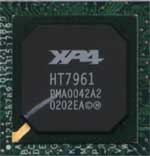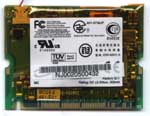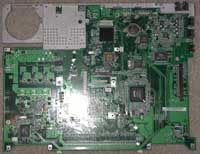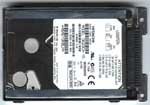The SiS 961 southbridge is mounted on the top side of the i-Buddie 4's motherboard. The chip incorporates quite a few devices on it, including an AC 97 audio controller, a USB 1.1 controller, and an ethernet controller. The SiS 961 also provides two IDE channels running at the ATA100 specification. The chip is mounted on the left side of the motherboard.

ECS turned to VIA to provide the USB 2.0 and IEEE-1394 support that the i-Buddie 4 incorporates. The USB 2.0 controller is a VIA VT6202 chip mounted on the left side of the motherboard. On the opposite corner a VIA VT6306 controller is found. This chip serves as the firewire controller for the i-Buddie 4.
Under the small black heatsink on the top middle of the motherboard lies a SiS 301LVMV chip. This chip accompanies the 650's integrated video and drives the i-Buddie 4's s-video out jack that is found on the back of the system. Apparently this chip gets warm enough during operation to justify the use of a small heatsink.
The integrated modem sits in a socket on the motherboard's right side.
Also found on the bottom side of the i-Buddie 4's motherboard are three Winbond chips, the W83L784AR, the W83972D, and the W83L517D. The Winbond W83L784AR is the system's hardware monitoring chip which measures the temperature of the area around the CPU as well as the temperature of the voltage regulators. If either of these temperatures get too high, the system kicks in additional cooling created by increasing the RPM speed of the two internal fans. The Winbond W83972D serves as the i-Buddie 4's AC 97 audio controller. Finally, the W83L517D appears to be a SuperI/O chip.
The middle of the motherboard was also home to a set of tiny dip switches. The switches were mounted below the BIOS chip but we are not sure what they are used for.
Since there are no PCMCIA expansion slots on the i-Buddie 4 (remember, it is really a desktop), there is no PCMCIA controller mounted on the motherboard. This limits the expandability of the notebook, as the system cannot accept PCMCIA cards (like a notebook) nor can it take PCI cards (like a desktop). Luckily, the majority of the necessary components are located onboard.
Although lots of the i-Buddie 4 is desktop based, the hard drive that the system uses is not. Likely for size and cooling reasons, the i-Buddie 4 uses a notebook hard drive. The hard drive in our i-Buddie 4 was a 15.0GB Hitachi DK23CA-15 hard drive. The drive spins at 4200RPM and has a 12ms access time. The DK23CA-15 is fairly similar to other mobile hard drives we have seen. The drive may fit well in the system but it also kills any hope that the i-Buddie 4 will truly perform like a desktop machine. We can't be sure why ECS didn't chose a more powerful 5400RPM mobile hard drive for the i-Buddie 4, especially since power consumption is not an issue. The faster hard drive would have certainly helped system performance.
The two speakers on the i-Buddie 4 were fairly large with generous chambers behind them. Sound out of the system was good but certainly not great and definitely not desktop-like.
As we mentioned before, the i-Buddie 4 contains no battery. There is an optional 12 cell external battery pack for the i-Buddie 4 that is speced at 2000mAh and 88 Wh. Although the specs suggest that the battery is quite powerful, we can not be sure how long it would power the desktop based i-Buddie 4.














0 Comments
View All Comments